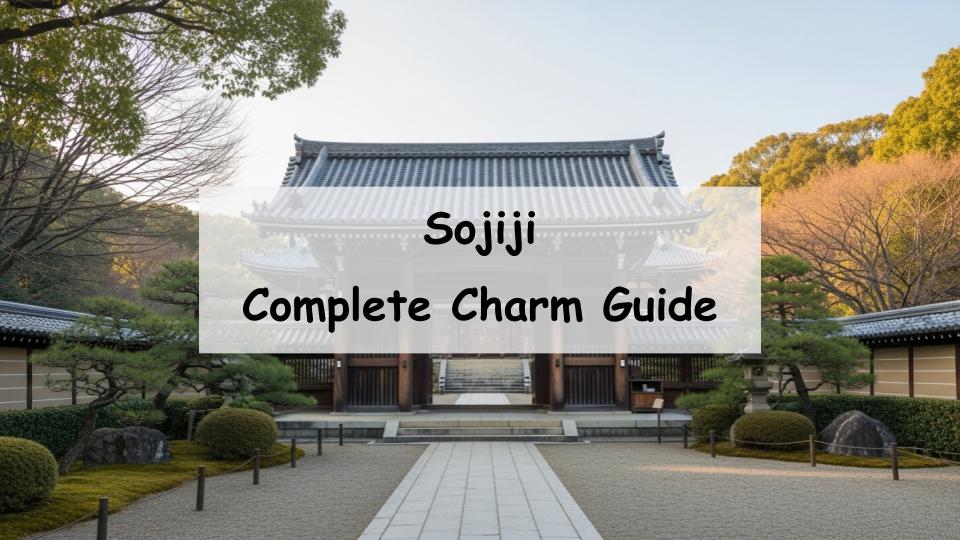Looking for a travel destination rich in history and culture? Wondering, “What is Sojiji Temple all about?” or “What are the must-see spots there?” If these questions sound familiar, you’re in the right place.
In this article, we’ll introduce the many attractions of Sojiji Temple, its unique characteristics, must-visit highlights, and detailed access information. By the end, you’ll know everything you need to plan your visit. Let’s explore the peaceful and captivating world of Sojiji Temple together.
What is Sojiji Temple? History and Basic Information
The Founding and Origins of Sojiji Temple
Sojiji Temple was founded in 1321 by Zen master Keizan Jokin. Originally located in Noto, Ishikawa Prefecture, the temple was relocated to Tsurumi, Yokohama in 1898 after a fire. Since then, it has served as one of the main training centers for monks in the Soto school of Zen Buddhism.
Role as a Head Temple of the Soto School
Sojiji is one of the two head temples of Soto Zen Buddhism, along with Eiheiji in Fukui Prefecture. It plays a vital role as a spiritual and training hub for Zen monks across Japan. Visitors can often witness monks engaged in daily rituals such as chanting and cleaning, offering a rare glimpse into authentic Zen practice.
Overview and Atmosphere of the Grounds
The temple grounds are vast and tranquil, featuring structures like the Main Hall, Founder’s Hall, and the grand Sanmon Gate. These architectural marvels stand in harmony with the serene environment, creating a space where time seems to slow down. Walking through the temple paths offers a calming and meditative experience.
Highlights of Sojiji Temple
Designated Cultural Properties and Architectural Beauty
Sojiji Temple is home to several nationally designated cultural properties. The Main Hall, in particular, is admired for its traditional Kara-style architecture and intricate woodwork. These historical buildings are not just religious sites but also masterpieces of Japanese craftsmanship that inspire awe in all who visit.
Gardens and Natural Scenery
Nature lovers will appreciate the seasonal beauty of Sojiji’s gardens. Cherry blossoms in spring, lush greenery in summer, and vibrant autumn leaves all enhance the spiritual ambiance. The temple’s natural surroundings complement its spiritual atmosphere, offering visitors a full sensory experience of peace and beauty.
Annual Events and Ceremonies
Throughout the year, Sojiji Temple hosts various traditional events such as the New Year’s “Daihannya Ceremony” in January and the “Segaki Ceremony” in August. These rituals are open to the public, offering a chance to witness and participate in age-old Buddhist traditions not commonly seen elsewhere.
How to Join Zazen and Other Experiences
Sojiji offers zazen (seated meditation) and other practices like sutra copying for visitors. With advance reservations, anyone can participate and experience a slice of Zen monk life. These programs provide a rare opportunity to slow down and reconnect with oneself in a sacred setting.
What Makes Sojiji Temple Special
A Sanctuary Away from Urban Noise
Despite its location in urban Yokohama, Sojiji Temple feels worlds apart from the city’s hustle and bustle. Once inside the grounds, a profound sense of calm replaces the noise, making it a perfect retreat for anyone seeking peace and inner reflection.
A Welcoming Spot for First-Time Visitors
Even for those unfamiliar with Buddhism or Zen, Sojiji Temple is easy to enjoy. Multilingual signage and informative brochures help visitors understand the site’s history and significance. Whether you’re there for architecture, nature, or quiet contemplation, you’ll find it accessible and enriching.
A Must for History and Buddhism Enthusiasts
With its centuries-old legacy and living Zen traditions, Sojiji Temple is a treasure trove for history buffs and spiritual seekers alike. Unlike many tourist-focused temples, Sojiji maintains its role as a functioning monastery, giving visitors a more authentic and profound experience.
How to Get to Sojiji Temple
By Train or Bus
Sojiji Temple is conveniently located about a 7-minute walk from JR Tsurumi Station or Keikyu Tsurumi Station. It’s easily accessible from central Yokohama and even Tokyo, making it a great addition to your travel itinerary.
By Car and Parking Information
If you’re driving, Sojiji offers parking spaces for temple visitors. However, during busy seasons or major events, parking may be limited. Nearby public parking is also available as an alternative. Checking in advance is recommended.
Suggested Routes with Nearby Attractions
Consider pairing your visit to Sojiji with nearby spots like Mitsuike Park or a stroll along the Tsurumi River. The temple also connects well with other major Yokohama attractions such as Chinatown and Minato Mirai, making it easy to create a full day of exploration.
Visiting Tips and Best Times
Opening Hours and Admission
The temple is open from around 9:00 AM to 5:00 PM daily, and general admission is free. However, certain special exhibitions or areas may require a fee. Be sure to check the official website for the most up-to-date information before your visit.
Avoiding Crowds
Peak times include New Year’s, Obon, and the fall foliage season. To enjoy the serene atmosphere, visit on weekday mornings when the grounds are quieter. Early visits also offer the best lighting for photography and uninterrupted exploration.
Photography and Visitor Etiquette
While photography is generally allowed, certain areas—especially during ceremonies or inside halls—may have restrictions. Please be respectful of monks in training and maintain a quiet, respectful demeanor throughout your visit. Observing proper etiquette ensures a meaningful experience for everyone.
Conclusion: A Journey to Inner Peace at Sojiji Temple
The Healing Power of Sojiji
Sojiji Temple combines spiritual depth, architectural beauty, and natural tranquility in one location. Whether you’re seeking inner peace, cultural enrichment, or simply a quiet break from daily life, the temple offers something truly special.
Final Words for First-Time Visitors
If you’ve never been to Sojiji Temple, now is the perfect time to go. Let your journey begin with curiosity, and leave with a renewed sense of calm and inspiration. A visit to Sojiji is not just sightseeing—it’s a meaningful experience you won’t forget.







Comment